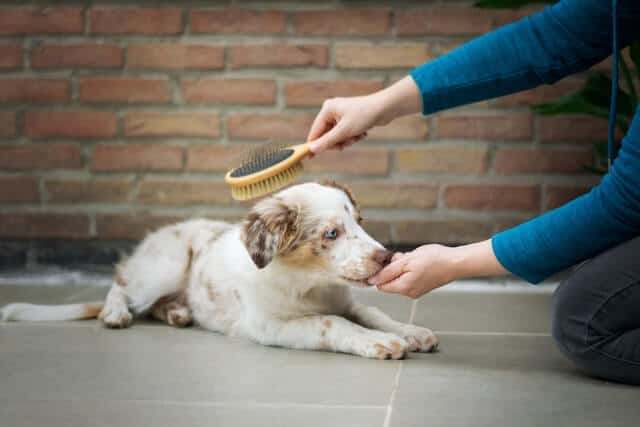When the weather changes, it may seem like your dog’s shedding goes into overdrive. That’s not too far from the truth. Dogs have a normal hair cycle that includes periods of higher hair growth and shedding than at other times. If you’re a pet parent to cold weather or water breeds like Malamutes or Labrador Retrievers, you should expect near year-round shedding interspersed with times when piles of dog hair seem to take over your home. The canine hair cycle also changes as dogs age and during different periods of life. A better understanding of how much shedding is normal can help you manage your dog’s hair cycle and give you a heads-up on when a change in shedding could indicate a health problem.
When (and How Much) Shedding is Normal and Healthy

Image courtesy of Unsplash
First, all dogs shed, but some dogs shed more than others.1 Normal shedding patterns depend on a dog’s coat type, their living environment (inside or outside), and the season/climate. Some breeds like Akitas, Chow Chows, German Shepherds, and Labrador Retrievers shed year-round. Water dogs and dogs bred for colder climates often have a double coat with a finer inner hair layer covered by a longer, coarser hair layer. Some breeds have periods where they “blow” their coat, shedding large volumes of hair that come out in handfuls. Yet, for these breeds, that’s normal.
When the days shorten, the summer coat is shed to make room for a heavier, warmer winter coat. Conversely, higher temperatures and longer days in the spring trigger shedding and the regrowth of a lighter summer coat. Breeds with a single coat tend to shed more lightly throughout the year.
Health and grooming factor into the shedding, too. Dogs who eat a healthy, balanced diet and receive regular grooming tend to shed less. Seasons of life can also change a dog’s normal shedding pattern. For example, puppies, with their fine, fluffy coats, shed a lot as their adult coat grows in.2 The hormonal changes of pregnancy and birth can cause excess shedding, too.
Potential Causes of Excess Shedding
Shedding may be normal, but a drastic change in hair loss patterns can indicate a problem. Some of the more common health conditions that affect shedding include:
- Allergies: Skin allergies can contribute to excess shedding. Dogs may be allergic to pollen, mold, house mites, flea bites, food, and more. 3
- Stress and Anxiety: Whether it’s a specific stressful situation or a dog that’s naturally frightened and nervous, stress and anxiety can get the fur flying.4 A trip to the vet, moving to a new home, or giving birth can all be stressful enough to cause your dog to shed more than usual. If it’s a temporary situation, like a trip to get groomed or a checkup at the vet’s office, try to soothe your dog as much as possible, but the shedding will subside once he’s not stressed anymore. Some dogs have serious anxiety issues, which usually come with more symptoms than just extra shedding. However, you can help get shedding under control by talking to your dog’s vet to determine ways to help ease anxiety.
- Thyroid Issues: Hypothyroidism causes hair loss in humans and canines.5 A veterinarian can perform blood tests to diagnose a thyroid issue, which can then be treated through medication.
- Poor Diet: A dog that doesn’t get enough of or the right nutrients may lose hair and experience other symptoms of a nutritional deficiency.6 If the diet is at the heart of hair loss, you can work closely with a veterinarian to come up with a solution. It could be dog food with the right nutrition for your dog’s breed, size, and age or a nutritional supplement. The problem could also be a medical condition that interferes with the ability to absorb certain nutrients.
- Adrenal Disease: The most common adrenal disease in dogs is Cushing’s disease, which is associated with excess cortisol production usually because of a non-cancerous tumor on the pituitary gland.7 Other noticeable symptoms may include increased appetite, pot-bellied appearance, and increased drinking and urination.
- Parasites and Infections: Pay attention to whether the hair is falling out on its own or being scratched out by the dog. If bald patches unrelated to scratching and licking show up, a nutritional or another internal issue could be at work. However, if your dog can’t stop scratching and itching, the excess shedding or irritated bald spots may be due to a skin infection, allergy, or parasite.8 Once appropriate treatment takes effect, the hair should grow back.
How to Manage Your Dog’s Shedding

Photo courtesy of Unsplash
Managing shedding is part of pet ownership. The best way to make sure your dog’s coat, and therefore his shedding, remains healthy is to feed him a nutritious diet, groom him regularly, and schedule regular veterinary care.
Depending on the breed and their coat type, you may need to brush out your dog once or twice a week… or even daily! Some dogs need more brushing, and others less. For example, an indoor, short-haired dog may only need a good brushing once a month. (Indoor pets tend to shed less because the light and temperature levels remain more consistent than in the outdoors.) In the spring and summer, when shedding increases, plan on doing a little extra brushing.
Stay on top of any health issues. Dogs with allergies or other health conditions may need a skin and coat supplement or medication to keep their skin and coat healthy. Mental health is important, too. If your dog shows signs of separation anxiety like increased shedding and excess barking, digging, or chewing while you’re away, you may need to consult a veterinarian or canine behaviorist to determine how you can help your pup stay calm.
Conclusion
It pays to keep an eye on and know your dog’s regular shedding patterns. Familiarity with when and how much is normal for your dog can alert you to changes that indicate a health issue.
- AKC Staff. Dog shedding: What to expect and how to manage it. AKC.org. Published April 3, 2019. Accessed March 12, 2021.
- AKC Staff. Why do puppies shed their coats? AKC.org. Published February 5, 2021. Accessed March 12, 2021.
- White SD, Moriello KA. Allergies in dogs. MSD MANUAL Veterinary Manual. Updated June 2018. Accessed April 12, 2021.
- Weir M and Buzhardt L. Signs your dog is stressed and how to relieve it. VCAHospitals.com. Accessed on March 12, 2021.
- Hypothyroidism (underactive thyroid). niddk.nih.gov Accessed March 12, 2021.
- Marchegiani A, Fruganti A, Spaterna A, et al. Impact of nutritional supplementation on canine dermatological disorders. Vet Sci. 2020; 7(2): 38. doi: 10.3390/vetsci7020038
- Cushing’s disease. Vetmed.wsu.edu Accessed March 12, 2021.
- Common canine skin conditions. vetmed.tamu.edu Published on July 15, 2016. Access on March 12, 2021.














